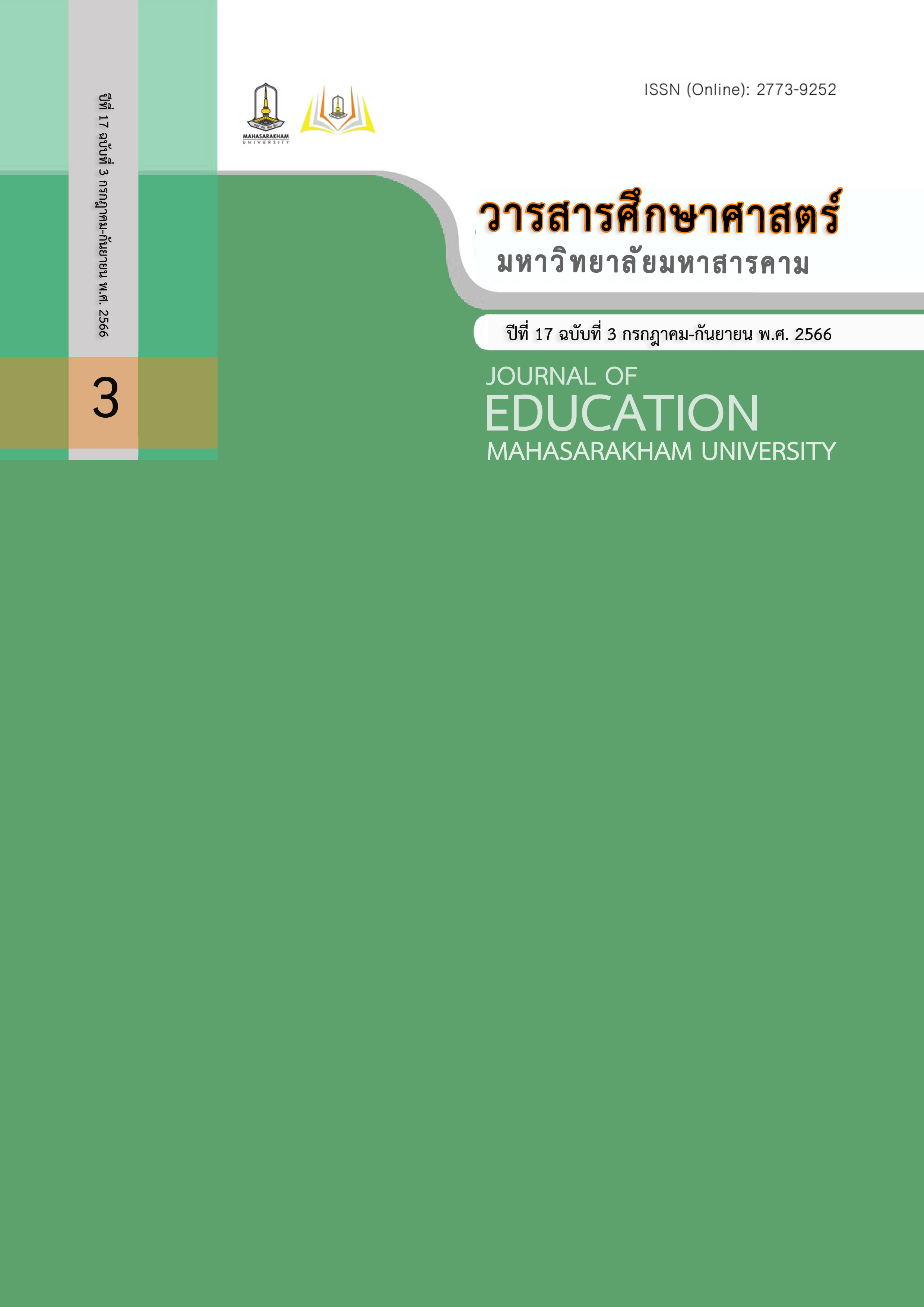The Development of Mathematical Achievement and Problem Solving Ability by Using SSCS Activities in Subject of One Variable Linear Equation for Mathayomsuksa 1
Main Article Content
Abstract
The purposes of this research were to 1) develop SSCS learning activities plan in subject of one variable linear equation to reach the efficiency criterion 80/80, 2) compare the achievement results between pre-test and post-test by using SSCS learning activities, 3) compare the results of mathematical problem solving ability between pre-test and post-test by using SSCS learning activities, and 4) study the students’ satisfaction with SSCS learning activities. A sample group of this research was 40 students attending in Mathayomsuksa 1, Kantarawichai School, Kantarawichai District, Mahasarakham Province selected by Cluster RandomSampling. The tools used in the research were: 1) the 16 learning activity plans by using SSCS, 2) the 30 items of multiple choice academic achievement tests, 3) the 4 items of mathematical problem ability subjective tests, and 4) the 15 items of a 5-scale questionnaire measuring the students’ satisfaction for learning activities by using SSCS. Statistics employed in the research consisted of percentage, means, standard deviation and t-test statistics (t-test dependent samples). The results of the research are as follows: 1) the E1/E2 efficiency of SSCS learning activity plan in subject of ‘one variable linear equation’ was 81.11/88.00 which was higher than the standard (80/80), 2) the post-test learning achievement results by using SSCS activities was higher than the pre-test one with the significance of .05, 3) the post-test results of problem solving ability in mathematics by using SSCS activities was higher than pre-test with the significance of .05, and 4) the students’ satisfaction with SSCS learning activities was at high level with the average of 4.01.
Downloads
Article Details

This work is licensed under a Creative Commons Attribution-NonCommercial-NoDerivatives 4.0 International License.
References
กระทรวงศึกษาธิการ. (2551). หลักสูตรแกนกลางการศึกษาขั้นพื้นฐาน พุทธศักราช 2551. กรุงเทพฯ : ชุมนุมสหกรณ์การเกษตรแห่งประเทศไทย จำกัด.
จีราวะดี เกษี. (2560). ผลของการจัดกิจกรรมการเรียนรู้แบบ SSCS เพื่อส่งเสริมความสามารถ ในการแก้ปัญหาทางคณิตศาสตร์ และผลสัมฤทธิ์ทางการเรียนวิชาคณิตศาสตร์ ของนักเรียนชั้นมัธยมศึกษาปีที่ 3. วิทยานิพนธ์ปริญญาการศึกษามหาบัณฑิต สาขาวิชาหลักสูตรและการสอน คณะศึกษาศาสตร์ มหาวิทยาลัยมหาสารคาม.
ชัยวัฒน์ สุทธิรัตน์. (2553). 80 นวัตกรรมการจัดการเรียนรู้ที่เน้นผู้เรียนเป็นสำคัญ. พิมพ์ครั้งที่ 3.กรุงเทพฯ : แดเน็กซ์ อินเตอร์คอร์ปอเรชั่น.
ณิชา พันธ์กนก. (2565). การจัดการเรียนรู้แบบ SSCS เพื่อพัฒนาความสามารถในการแก้ปัญหาทางคณิตศาสตร์ ของนักเรียนชั้นมัธยมศึกษาปีที่ 5. วิทยานิพนธ์ปริญญาการศึกษามหาบัณฑิต สาขาวิชาหลักสูตรและการสอน คณะศึกษาศาสตร์ มหาวิทยาลัยมหาสารคาม.
ธันยพัฒน์ พันธุ์พำนัก. (2562). การจัดการเรียนรู้ด้วยรูปแบบ SSCS เพื่อส่งเสริมผลสัมฤทธิ์ทางการเรียนและทักษะการแก้ปัญหาทางคณิตศาสตร์ เรื่อง ความน่าจะเป็น ชั้นมัธยมศึกษาปีที่ 3. วิทยานิพนธ์ปริญญาวิทยาศาสตรมหาบัณฑิต สาขาวิชาคณิตศาสตรศึกษา คณะวิทยาศาสตร์ มหาวิทยาลัยมหาสารคาม.
บุญชม ศรีสะอาด และคณะ. (2555). วิธีการทางสถิติสำหรับการวิจัย. พิมพ์ครั้งที่ 6. กาฬสินธุ์ : ประสานการพิมพ์.
เบญจพร ตะคอนรัมย์. (2564). การจัดการเรียนรู้ด้วยรูปแบบ SSCS ที่ส่งเสริมความสามารถในการแก้ปัญหาวิชาคณิตศาสตร์ เรื่อง บทประยุกต์ สำหรับนักเรียนชั้นประถมศึกษาปีที่ 6. วิทยานิพนธ์ปริญญาวิทยาศาสตรมหาบัณฑิต สาขาวิชาคณิตศาสตรศึกษา คณะวิทยาศาสตร์ มหาวิทยาลัยมหาสารคาม.
วิภาดา คล้ายนิ่ม. (2560). การศึกษาผลสัมฤทธิ์ทางการเรียนคณิตศาสตร์ของนักเรียนชั้นมัธยมศึกษาปีที่ 5 เรื่อง ความน่าจะเป็น โดยใช้รูปแบบ SSCS. วารสารศึกษาศาสตร์ มสธ., 10(2), 329-343.
สถาบันส่งเสริมการสอนวิทยาศาสตร์และเทคโนโลยี. (2555). ทักษะและกระบวนการทางคณิตศาสตร์. พิมพ์ครั้งที่ 3. กรุงเทพฯ : 3-คิว มีเดีย.
สำนักงานคณะกรรมการการศึกษาขั้นพื้นฐาน กระทรวงศึกษาธิการ. (2560). ตัวชี้วัดและสาระการเรียนรู้แกนกลาง กลุ่มสาระการเรียนรู้คณิตศาสตร์ ตามหลักสูตรแกนกลางการศึกษาขั้นพื้นฐาน พุทธศักราช 2551 (ฉบับปรับปรุง พ.ศ. 2560). กรุงเทพฯ : ชุมนุมสหกรณ์การเกษตรแห่งประเทศไทย จำกัด.

